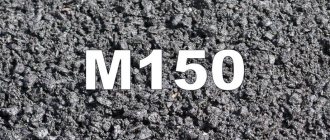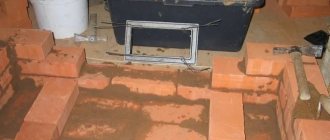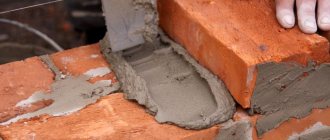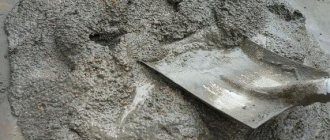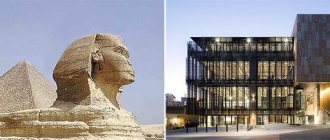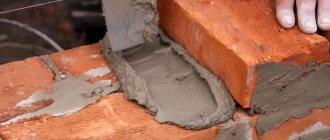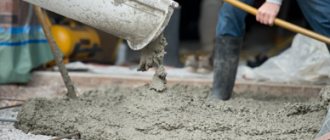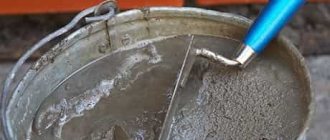In attempts to save money, especially in the case of arranging a summer cottage, you often have to sacrifice good quality. However, there is a simple solution - to use budget analogues correctly. Today I decided to write about one of these materials. Concrete M150: characteristics, proportions of basic components for mixing the mixture yourself, acceptable use cases.
Source 22.img.avito.st
Material Specifications
In factory conditions, the quality and composition of concrete grade M150 is controlled in accordance with the requirements prescribed in GOST 7473 of 2010. The basic composition of the material includes Portland cement CEM I 32.5H (M400) or CEM I 42.5H (M500), river or quarry sand with a fraction of 1.5-2 mm and solid filler. This can be gravel or crushed stone from natural raw materials with a size of 5-40 mm (breakability from 300 to 600 units). It is also allowed to add broken bricks and other construction waste (plaster, glue, screed, tiles). The water used is potable or technical with a minimum content of impurities.
The table presents the technical characteristics of the composition, which is considered by users and designers.
| Parameter | Meaning | Peculiarities |
| Compressive strength | 130-160 kgf/sq.cm | If the composition is supplemented with fiber fiber or the structure is additionally reinforced, the performance will be increased. For example, lime is lighter than granite. |
| Flexural strength | 10 kgf/sq.cm | |
| Strength class (B) | 10-12.5 MPa | |
| Density (D) | 900-2200 kg/cub.m | The specific gravity of a cubic meter of M150 concrete can reach 2275 kg if high-density gravel of various fractions is used as a filler. |
| Frost resistance | F50 | If necessary, the number of freezing and thawing cycles can be increased. To do this, a water-repellent additive is added to the concrete solution. But here it is important to take into account that the component can negatively affect other technical characteristics of the monolith. |
| Waterproof | W2-W4 | This refers to the ability of the dry residue to absorb water during the day. In particular, 4 or 6% of the total volume of the sample. |
| Mobility | P1-P4 | Plasticity (or workability) depends directly on the water added to the solution. The more of it there is in the composition, the more fluid it is. However, there are pitfalls here too. Liquid concrete is easier to compact and distribute throughout the site, and “drive” into corners. But an excessive amount of water will subsequently negatively affect the strength and density of the monolith. |
Due to its low density, concrete M150 belongs to the group of light mixtures (LMC). It is characterized by rapid hardening, which cannot be said about its closest analogues with the M100 and M200 brands. If certain additives are added to the base components, the technical indicators may differ from those presented in the table.
Concept of brick
This is a regularly shaped block of various sizes, made from clay with the addition of a small amount of sand. It is fired in special furnaces at temperatures from 300 degrees, it is possible to add mineral additives to improve characteristics. Each batch produced by the workshop undergoes mandatory testing to ensure that it is assigned a specific brand. The brand of brick indicates several basic parameters: strength and frost resistance.
The frost resistance grade of brick plays an important role in the construction of buildings in cold winters, when the external load on the walls is maximum. It is better to initially buy products with F-50 and higher ratings. If you follow construction technology, the average service life of a building is up to 50 years in difficult winter conditions.
The strength grade of a brick is an indicator of the maximum load per unit area of the material. The higher it is, the stronger the structure will be; high-rise buildings can be built.
Recipe for making your own solution
At a construction site, most craftsmen prefer to prepare the working mixture themselves. This is justified by the lower cost of materials and the longer time it takes to work with the solution. The only drawback here is the quality of the finished composition that is not controlled by the laboratory.
To minimize losses in relation to technical characteristics, you can rely on GOST or recommendations from specialists. The latter are presented in the table: the proportions of the basic components in M150 concrete.
| Components | For CEM I 32.5H | For CEM I 42.5H | ||||
| in parts | in kg. (l.) | in buckets (10 l) | in parts | in kg. (l.) | in buckets (10 l) | |
| Cement (PC) | 1 | 215 | 16,5 | 1 | 190 | 14,6 |
| Dry sand | 3,5 | 735 | 52,5 | 4,5 | 755 | 54 |
| Gravel | 5,7 | 1140 | 81,5 | 6,6 | 1140 | 81,5 |
| Water | 0,9 | 190 | 19 | 1 | 190 | 19 |
At a construction site, the same mistakes are often made regarding the volume of water in the composition of M150 concrete or another grade. The reasons come down to unaccounted for moisture, which is contained in wet sand or plasticizers. As a result, the solution turns out to be too liquid, which means the monolith will not meet the expected quality.
Brick brand
Brands of ceramic bricks are an important criterion for choosing the optimal building material. The nomenclature is regulated by GOSTs, testing is carried out for each batch, and several copies of the finished product are selected at random in order to determine all the parameters, including bending resistance, in laboratory conditions. For each type of material, a certificate of conformity is issued, which indicates the parameters of strength, frost resistance, degree of porosity, as well as the presence or absence of additional mineral additives. Fire bricks do not pass the frost resistance test; they have a different purpose; often during production, iron mineral salts are added to the clay to increase fire resistance. Determining the brand of brick cannot be done visually; it is a lengthy laboratory process, which is carried out at the factory or in specialized testing organizations.
How to choose the optimal building material when building a house
The classification of brick is quite extensive; it is a popular product. Therefore, when purchasing building materials, especially from a manufacturing plant, you should immediately be interested in the parameters of the batch.
The grade of brick for external walls must be at least M-100, or higher. But the stronger the brick, the heavier it is; the foundation must be strong. For internal masonry, brick grade is M-50, M-75. If you need to clad the facade of a house, then for this purpose you buy building material, where the grade of the facing brick is M-75, and the frost resistance is F-50 and higher.
Application area
Let's look at where M150 concrete is used. Usually, when it comes to concrete solutions, they can be used for almost any type of construction work in the private sector. However, the technical characteristics of a particular composition limit the permissible types of installation activities. For example, due to the low weight of a cubic meter of M150 concrete, and therefore low density, it cannot be used for the construction of critical, loaded structures.
If we talk about the foundation, then the composition can be used in two cases. This can be an independent reinforced base for an extension, gazebo or shed. In the case of residential buildings, only the installation of a layer between the soil and the foundation is permissible. The same applies to the road surface or storage area for vehicles.
Source pkdom.ru
As a rule, the scope of application of M150 concrete extends to the interior decoration of the building. This could be leveling screed, plastering walls, erecting partitions. Of course, the composition does not always contain gravel or crushed stone. In the yard, the solution is useful when concreting pillars, decorating paths with curbs, laying paving slabs or artificial stone.
In this video, the master explains and demonstrates how to properly mix concrete mortar in a concrete mixer:
What is concrete M150 used for?
Low price and ease of manufacture make M150 concrete mortar an extremely popular material. It is used to solve a wide range of problems in construction:
- creation of a reinforced foundation cushion on equipped waterproofing;
- pouring foundations for light one-story buildings and temporary structures;
- floor screed in domestic premises, industrial, commercial or public facilities with low load on the floor;
- arrangement of personal, garden or park paths, and courtyards, pedestrian areas;
- laying road base under asphalt;
- production of slabs and blocks for load-bearing structures under light loads;
- erection of fences, installation of pillars; construction of partition walls.
When erecting structures made of M150 concrete, care must be taken to install drainage and waterproofing systems. When constructing a screed, the top layer is reinforced using cement or special additives.
This material is inexpensive compared to other solutions, which reduces the cost of construction work. It is quite resistant to temperature changes and high humidity, provided it is properly waterproofed. This is an environmentally friendly material that can be used without restrictions in the construction of residential premises and other buildings and structures.
Application of concrete grade M100
Concrete mortars of the M100 grade have found their purpose in preparatory work, as a rule, for the construction of foundations and monolithic slabs, as well as for the construction of concrete pads for asphalt roads and for the installation of curbs. More specifically, a concrete pad is made from this solution, which is formed in a thin layer on a sand or gravel embankment (preparation). After the mixture has set, they begin constructing the reinforcement cage and further concreting the already high-grade mortar.
It often happens that this stage is neglected, they say, a lot of time and money are spent on pouring the preparatory layer, but there is no point, because even without it you can make a full-fledged structure without losing quality and strength. No, this is not a full-fledged structure and the reinforcement that sits in the bedding layer will corrode under the influence of water, which is not good and threatens with various consequences in the next few years.
Application of concrete grade M500
Like the previous grade, grade 500 concrete is intended for special-purpose structures, hydraulic engineering, underground construction and industrial construction of large-scale structures.
It is worth mentioning that in the design documentation this brand is referred to as M550, but in common people it was dubbed the five hundredth. Also, as in the cases with previous brands, this brand is not used in civil residential urban and suburban construction.
Application of concrete grade M400
High-strength concrete grade 400 makes it possible to produce structures intended for use under extreme loads. More specifically, this is the production of bridge structures, structural elements of hydraulic structures, swimming pool bowls, and money depositories in banks. It is also used in the production of structural elements with special requirements for industrial construction: columns, crossbars, beams for the production of massive crane structures with high load capacity.
This concrete is a highly specialized and expensive building material, and also has a colossal margin of safety and a high setting speed. Due to this, it is not in high demand and is not popular in civil engineering.
Application of concrete grade M300
Ready-mixed concrete grade 300 is used to a greater extent for the production of foundations of various structures (strip, slab, pile-grillage). It is clear that it is also suitable for the production of paths, blind areas, fence borders, stairs, construction of retaining walls for front gardens and more, pouring PP (floor slabs), monolithic walls, etc.
Although it is the most popular among most areas of construction, according to the technical specifications it occupies an intermediate level in the strength class and should not be taken into account if designed in accordance with all construction rules and standards. However, concrete grade M300 is the best seller even above M200.
Purpose of ordinary brick M 150
Working brick M 150 with a solid structure and no voids is a poor heat-insulating material. But, having heavy weight and the highest strength, it is excellent for installing foundations and basic load-bearing structures.
Slotted brick of grade M 150, in the block of which there are voids, has even less weight and greater heat and sound insulation properties. Therefore, it is perfectly suitable for the construction of apartment and interior partitions and wall cladding.
Application of concrete grade M450
This brand of concrete mixture is used for the construction of large-scale structures such as dams, dams, bunkers, storage facilities, bridges and other lifting structures that are subject to special requirements. This grade of concrete is also used in the construction of underground communications and subways.
Such concrete is produced exclusively on granite crushed stone filler, often thickly with the use of plasticizers and other modifying additives. This concrete has high frost resistance and water resistance (W coefficient).
Due to its high cost and properties that are not at all needed in residential construction, as well as the complicated installation process (quick setting), it is not in demand at all. Therefore, the demand for it is minimal, since there is little such industrial and engineering construction.
How to determine the compressive strength of a brick?
Tensile strength
sample
is determined
by the formula: Rсж=P/F, where P is the greatest load on the sample, and F is the area of the transverse sample. If the thickness of the test sample is 88 mm, then the test result is multiplied by a factor of 1.2.
Interesting materials:
How to make a birdhouse for birds? How to make structured water correctly? How to make turunda correctly? How to properly ventilate under the floor of a private house? How to place an order for jum? How to make an entry in the PTS? How to make a bootable USB flash drive using ultraiso? How to sell a car with a registration ban? How to renew your driver's license? How to renew your driver's license?
Abundance of types of building bricks
Clay solid bricks are made by continuously firing raw clay (crushed, loosened, processed clay, which is then formed and dried) in kilns. The dimensions of solid clay bricks are standard 250x120x65 mm. There are also products with increased width: it is 138-140 mm.
Accordingly, the cost of solid clay bricks depends on the size; the larger the block, the higher its cost. To select and purchase solid clay brick , you should decide on its brand: from M-100 to M-300. Products vary in their ability to withstand compressive loads.
Introduction of bricks of different brands
For the construction of such low-rise buildings as cottages, boarding houses, recreation centers, hotels, personal and country houses, villas, houses, penthouses and household buildings, brick grades M-100 or M-150 are suitable. This strength is sufficient for the construction of load-bearing walls up to 3 floors high. If the brick has the lowest strength grade, it is intensively used for interior partitions, as well as buildings with low overload:
- gazebos;
- verandas;
- workshops;
- Summer kitchens;
- Warehouses;
- Hangars;
- sheds;
- Utility rooms;
- Garages;
- chicken coops;
- stable;
- stables;
- Greenhouses.
Brick 200 has found application in high-rise construction, while M-300 is used for the construction of foundations and plinths for high-rise buildings.
To save money, when building a personal one- and two-story house, you can lay out the base from M-150 brick. The overall picture is created by M-100 brick. On the construction market you can find a wide range of bricks of the M-75, M-100, M-125 and M-150 brands. A more popular product is the M-100 brick.
